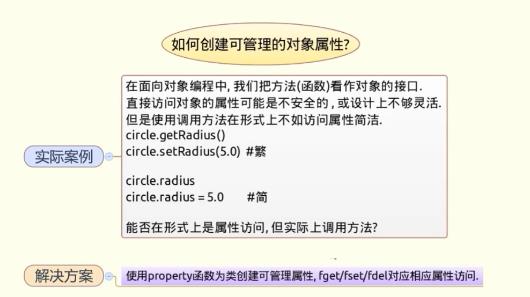7-4 如何创建可管理的对象属性
Posted 石中玉smulngy
tags:
篇首语:本文由小常识网(cha138.com)小编为大家整理,主要介绍了7-4 如何创建可管理的对象属性相关的知识,希望对你有一定的参考价值。


>>> help(property) Help on class property in module __builtin__: class property(object) | property(fget=None, fset=None, fdel=None, doc=None) -> property attribute | | fget is a function to be used for getting an attribute value, and likewise | fset is a function for setting, and fdel a function for del\'ing, an | attribute. Typical use is to define a managed attribute x: | | class C(object): | def getx(self): return self._x | def setx(self, value): self._x = value | def delx(self): del self._x | x = property(getx, setx, delx, "I\'m the \'x\' property.") | | Decorators make defining new properties or modifying existing ones easy: | | class C(object): | @property | def x(self): | "I am the \'x\' property." | return self._x | @x.setter | def x(self, value): | self._x = value | @x.deleter | def x(self): | del self._x | | Methods defined here: | | __delete__(...) | descr.__delete__(obj) | | __get__(...) | descr.__get__(obj[, type]) -> value | | __getattribute__(...) | x.__getattribute__(\'name\') <==> x.name | | __init__(...) | x.__init__(...) initializes x; see help(type(x)) for signature | | __set__(...) | descr.__set__(obj, value) | | deleter(...) | Descriptor to change the deleter on a property. | | getter(...) | Descriptor to change the getter on a property. | | setter(...) | Descriptor to change the setter on a property. | | ---------------------------------------------------------------------- | Data descriptors defined here: | | fdel | | fget | | fset | | ---------------------------------------------------------------------- | Data and other attributes defined here: | | __new__ = <built-in method __new__ of type object> | T.__new__(S, ...) -> a new object with type S, a subtype of T
property()三个参数分别是访问方法,设置方法。
from math import pi class Circle(object): def __init__(self,radius): self.radius = radius def getRadius(self): return self.radius def setRadius(self,value): if not isinstance(value,(int,long,float)): raise ValueError(\'wrong data type,please slecet int or long or float\') self.radius = value def getArea(self): return self.radius ** 2 * pi R = property(getRadius,setRadius) c = Circle(3.2) print (c.getArea()) print (c.R) #以属性方式访问,实际上调用的是getRadius c.R = 4 #以属性方式访问,实际上调用的是setRadius print(c.R) print(c.getArea())
输出结果:
32.1699087728
3.2
4
50.2654824574
以上是关于7-4 如何创建可管理的对象属性的主要内容,如果未能解决你的问题,请参考以下文章
